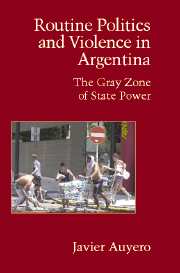Book contents
4 - Moreno and La Matanza Lootings
Published online by Cambridge University Press: 05 June 2012
Summary
[T]here is no contradiction between the fact that, on the one hand, mob violence may be highly organized and crowds provided with such instruments as voter's lists or combustible powders, and on the other that crowds draw upon repositories of unconscious images…. Hence, just as we study the organization and networks through which crowds are recruited, so must we document the organizing images, including rumours, that crowds use to define themselves and their victims.
Veena DasThus far, most of the reconstruction has been based on secondary sources (newspaper accounts, police reports, video footage, investigative journalists' descriptions). I now turn to my own fieldwork, which took place in Moreno and La Matanza. In Moreno, the following evidence comes mostly from El Cruce de Castelar (site of dozens of small stores, many of them looted during the week under investigation, hereafter El Cruce) and from Lomas Verde, a poor barrio located fifteen blocks from El Cruce from which many of the looters came. In the case of La Matanza, the evidence comes from the crossroads of Crovara and Cristianía (site of heavy looting activity, hereafter C&C) and from BID, a poor enclave situated thirteen blocks from it (also known as Barrio Villegas). In what follows I draw on in-depth interviews with owners, managers, and employees of stores located in both sites, with brokers of the Peronist Party and grassroots activists, and with residents of both barrios who either themselves participated in the lootings or knew someone who did.
- Type
- Chapter
- Information
- Routine Politics and Violence in ArgentinaThe Gray Zone of State Power, pp. 97 - 130Publisher: Cambridge University PressPrint publication year: 2007

